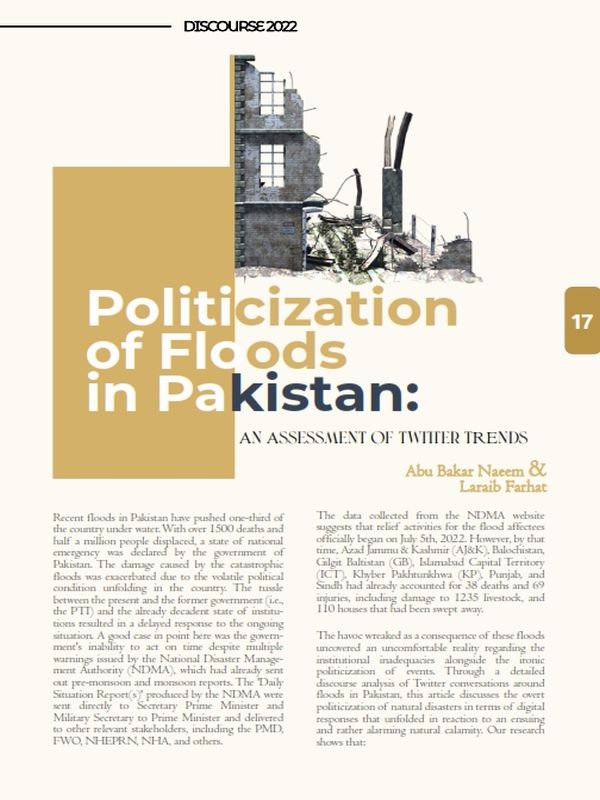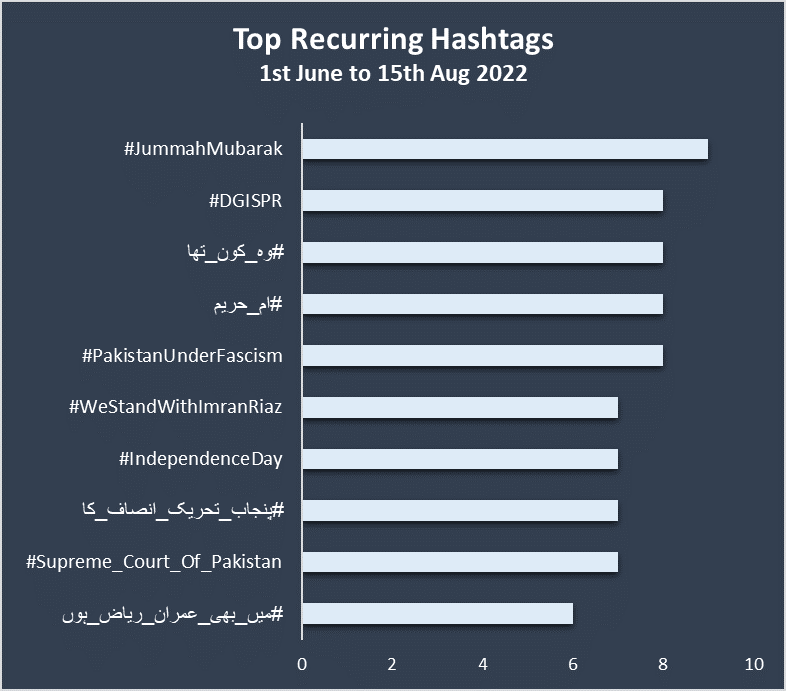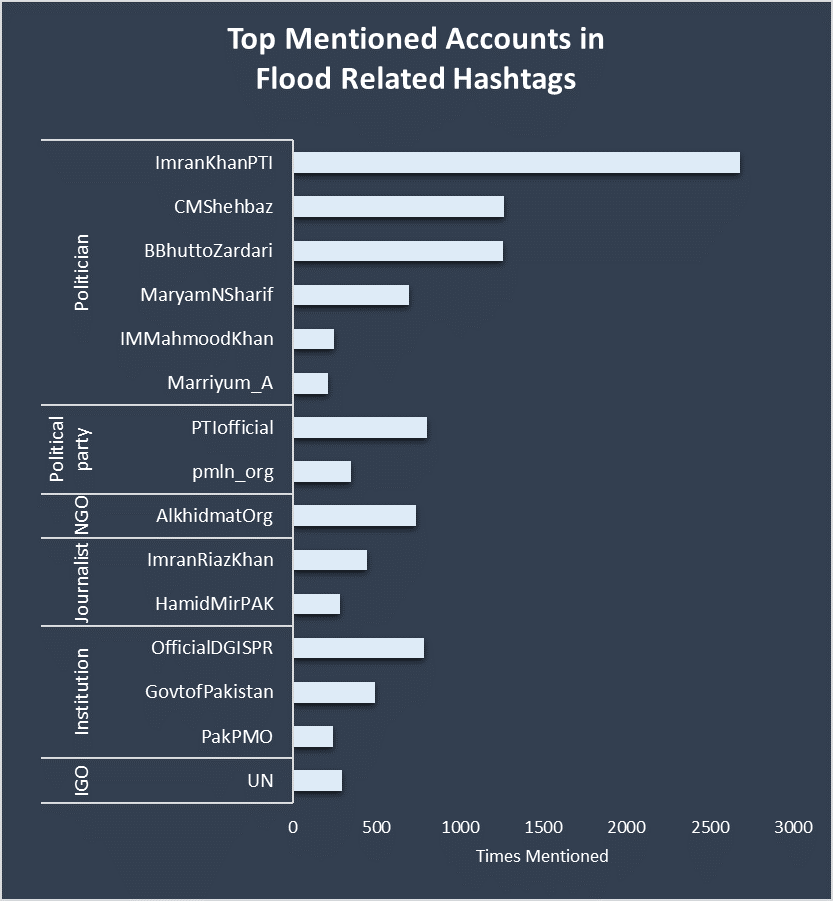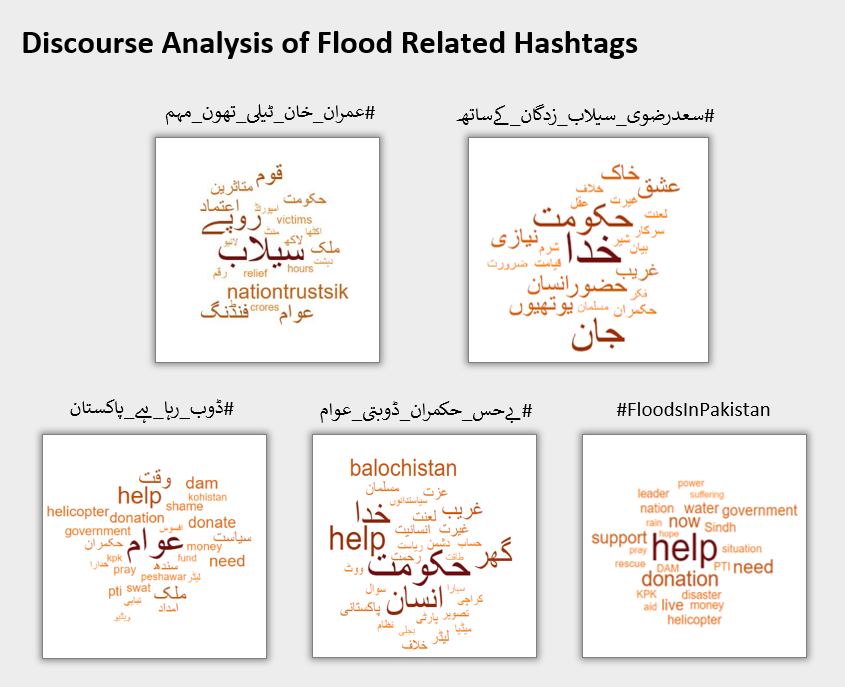Politicization of Floods in Pakistan: An Assessment of Twitter Trends
Recent floods in Pakistan have pushed one-third of the country under water. With over 1500 deaths and half a million people displaced, a state of national emergency was declared by the government of Pakistan. The damage caused by the catastrophic floods was exacerbated due to the volatile political condition unfolding in the country. The tussle between the present and the former government (i.e., the PTI) and the already decadent state of institutions resulted in a delayed response to the ongoing situation. A good case in point here was the government’s inability to act on time despite multiple warnings issued by the National Disaster Management Authority (NDMA), which had already sent out pre-monsoon and monsoon reports. The ‘Daily Situation Report(s)‘ produced by the NDMA were sent directly to Secretary Prime Minister and Military Secretary to Prime Minister and delivered to other relevant stakeholders, including the PMD, FWO, NHEPRN, NHA, and others. The data collected from the NDMA website suggests that relief activities for the flood affectees officially began on July 5th, 2022. However, by that time, Azad Jammu & Kashmir (AJ&K), Balochistan, Gilgit Baltistan (GB), Islamabad Capital Territory (ICT), Khyber Pakhtunkhwa (KP), Punjab, and Sindh had already accounted for 38 deaths and 69 injuries, including damage to 1235 livestock, and 110 houses that had been swept away.
The havoc wreaked as a consequence of these floods uncovered an uncomfortable reality regarding the institutional inadequacies alongside the ironic politicization of events. Through a detailed discourse analysis of Twitter conversations around floods in Pakistan, this article discusses the overt politicization of natural disasters in terms of digital responses that unfolded in reaction to an ensuing and rather alarming natural calamity. Our research shows that:
- The discourse on floods pervading on Twitter was primarily political
- Twitter users were more focused on directing their anger towards political parties for not responding effectively to the situation
To understand and analyze the online conversation regarding floods in Pakistan, specifically on Twitter, we scraped the top five hashtags that appeared on Pakistan’s Twitter panel from June 1st to August 30th, 2022. Following that, we further specified those hashtags into the flood-related category and scraped their tweets from the Twitter rest API for content analysis.
Interestingly, we found out that the conversation regarding floods on twitter begun quite later. The first flood-related hashtag appeared on August 18th, 2022 and by July 1st, 2022, the floods had already caused substantial damage to the country (as mentioned above in the NDMA report). Principally, the reason for this delayed response could be traced to the political situation in the country. For starters, it was mainly because the conversations around the Twitter panel during the initial days of floods were bordered by political actors which ultimately diverted the attention of general public from a widespread natural disaster to the political fiasco as shown in Figure 1.
Figure 1. Top Recurring Hashtags
Furthermore, the collected data also indicates that the digital response from the general public appeared more actively following August 18th, after the flood water had reached the level of relatable plight, i.e., the fear of a spillover effect. The following graph offers insights into the most trending hashtags by volume. It is noteworthy that while 1/3rd of the country was drowning in flood water—with several reported causalities and damage—political leaders were pulling strings behind the scenes to leverage the crisis in order to promote their personal (or political) agendas. For example, the first political party to appear on Twitter was the Tehreek-e-Labbaik Pakistan (TLP), with its hashtag: سعدرضوی_سیلاب_زدگان_کےساتھ#. Similarly, political parties in opposition also directed their agenda towards maligning the ruling party with hashtags like ڈوب_رہا_ہے_پنجاب#.
Figure 2 indicates clearly how political leaders took this disaster as an opportunity to push their narrative while deflecting blame and portraying local governments and political parties as ineffective.
Figure 2. Top 10 Flood Related Hashtags
Similarly, the data also showed an interesting deviation in pattern, i.e., the inclination of the general public to directly engage with ‘individual’ leaders instead of confiding in either the government (representatives) or public institutions, be it to direct their anger about inadequate disaster preparedness or to request rapid relief assistance. This insight also illustrates the widening trust deficit of the public in the government as an institution because ‘Govt of Pakistan’ was mentioned in the twitter conversations significantly less frequently than the political parties or politicians combined. Similarly, flood relief organizations, both national and international, did not gain expected traction, especially compared to the former Prime Minister of Pakistan (@ImranKhanPTI) – who was the most mentioned Twitter handle during this crisis, indicating the triumph of his brand of populism that gained him major support.
Figure 3. Top mentioned accounts in Flood Related Hashtags
To further our study, we carried out discourse analysis of the top 5 hashtags that appeared on Twitter panel. Through that, it became evident that the content generated via the hashtags depicted a public outcry and was more inclined towards sentiments related to appeals, help, disappointment, and suffering.
On the other hand, the politics-oriented hashtags were more persuaded towards generating a narrative against the opposition, political blaming, and promoting self-image as national heroes. Thus, this further strengthened the underlying argument that power politics in Pakistan is a dominant factor and catastrophes like floods or climate change become an opportunity for political leaders—to promote their own party’s agendas and narratives—rather than as a serious threat to traditional or human security. (See Figure 4)
Figure 4. Discourse Analysis of Flood Related Hashtags
Conclusion
Based on an exploratory-explanatory approach, this study has shown that Twitter conversations related to floods were politicized with more focus on political point scoring and deflecting blame than a consolidated bottom-up approach towards applying pressure on governing agencies for relief and, more broadly, infrastructural resilience. Importantly, a significant point of reflection that the data shows is that the current state of institutional frameworks (which are already inadequate) available for disaster management bears minimal space for political influence on digital spaces. Considering instances of repetitive incidents wherein political allegiances have trumped everything else, a more coordinated response from the political factions in the country, especially during crises such as floods, is something that may not only improve the current state of institutions but may also contribute to bridging the prevalent trust deficit between the public and the government as an ‘institution’ in such difficult times. Similarly, threats like climate change that cause these catastrophes, like floods, should be taken as a threat to human security and thus, should be treated like such. Any negligence in the required response can push the already vulnerable state of human security in Pakistan to a more weakened and fragile condition.
The authors are affiliated with the Institute of Regional Studies, Islamabad.








